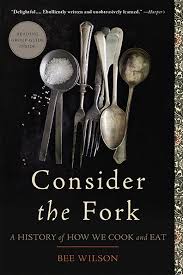When I saw the title on this Christmas present from Herself, I thought of Norbert Elias’s ‘The History of Manners’ (1939). The book at hand is broader than its title indicates. The subtitle pretty well sums it up, however, I would have been tempted to call it ‘Consider the Kitchen,’ because that is the culmination of the book.

Each chapter focuses on some essential aspect of food and eating in one word titles: fire, ice, knife, fork, grind, and, finally, kitchen. The fork which I begin to consider is important, to be sure, but it is only one element among seven others, hence my quibble about the title.
Ever wondered why a kitchen knife is sharp only one side? A table fork has four tines? Why was the freezer on top of the refrigerator until recently? Why are tin cans of food the size they are? Why are refrigerators powered by electricity when they use gas? How did the can-opener evolve?
Probably not, we take everyday things for granted, but there is much to learn from the answers to such questions. Successful innovations started by pandering to the expectations of consumers as in the case of refrigerators. The influence of major industries also figures, as electricity powered refrigerators, a boon to power companies because refrigerators, unlike light bulbs, are always on.
Here are few tidbits. Japanese knives are sharpened to 20 degrees while most European knives are sharpened to 30-35 degrees. Why? The difference traces back to a combination of the use of the knife and the material it is made from. The carbon steel layers that combine in a Japanese knife take the sharper angle. Though it is dangerously, lethally sharp it is confined to the kitchen for preparation. European knives are made from a different compound of metals, and the use of the knife is not so strictly regulated by convention to keep it in the kitchen, e.g., Europeans cut meats and carve birds at the table in way unknown to Japanese cuisine.
Most interesting of all is, of course, the greatest technology of cooking, the kitchen itself. At one time food was prepared in a lean-to behind the house, now the kitchen is often, usually the centre of home-life. There is the amusing story of post-kitchen renovation depression, after years of saving for, planing, selecting appliances, designing a new kitchen, when it is finally done…there is nothing to occupy every waking hour. There is but a void.
Chopsticks are another world. The lacquered and pointed Japanese ones are impossible. The flat steel Korean one with small raised striations for gripping the food are the easiest to use. In between are the plain Chinese wooden ones, which are used in such a quantity to threaten the forests of the country.
The discussion of the potato parer is wonderful. We put up with that primitive implement for generations until someone whom she names came up with a better way. We do put up with a lot of inconvenient things because that is just the way they are, until someone comes along and betters them.
In the 1920s Marion Mahony at Castlecrag designed kitchens in the front of houses, looking into the street, to reduce the social isolation of the housewife eliciting the consternation of local councils, mortgaging banks, and some clients. Certain patterns are ingrained. This incident is not included in this book but it seemed relevant.
By the way, the fork is credited to Catherine di Medici when wed to King Henri of France and mother to his successor. She had a household of Italians to Paris and from there emerged the fork. Of course Italians had been using it for years but it only entered the food culture when it was used in France. Another example of ideology over reality. By the way, she is routinely blamed for the Saint Bartholomew’s Day Massacre of Protestants.

Bee Wilson wears a great deal of learning lightly, and passes much in review with no distractions. An attentive reader will notice that there are a few aspects of the contemporary food culture that she disdains but without ever quite saying so, a subtlety that will pass most by.
Skip to content
